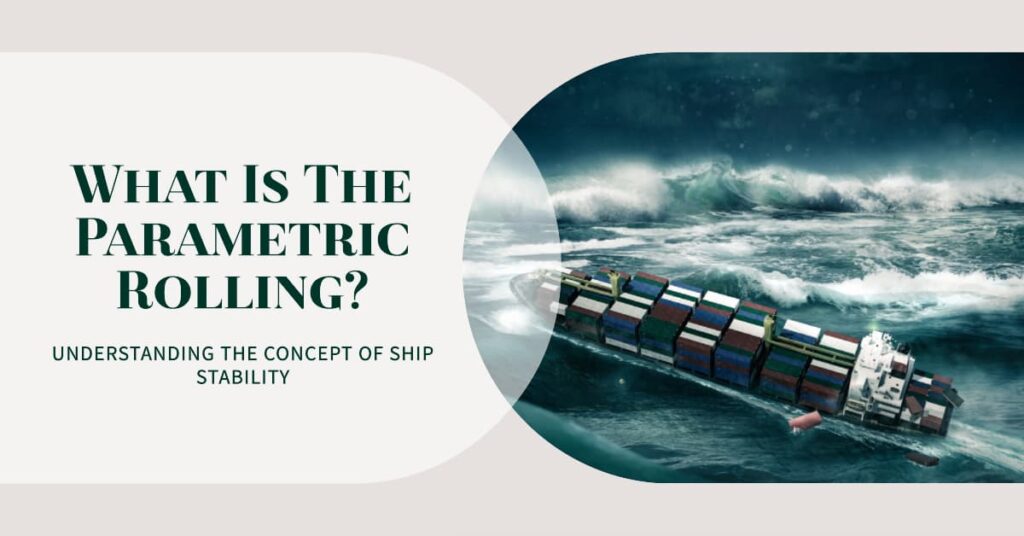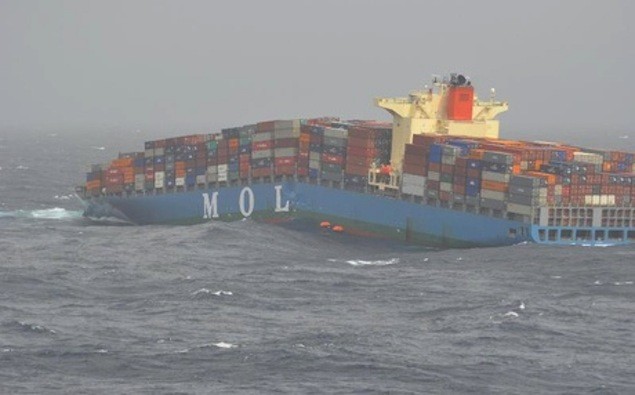A vessel has six degrees of motion namely surge, sway, heave, roll, pitch and yaw. The port to starboard rotation about the centerline is called roll motion and the forward and aft motion about the midship is called pitch motion, both of which are associated with parametric rolling.

Understanding Parametric Rolling
Parametric rolling is a dynamic instability caused due to combination of various factors when a vessel is in motion. Parametric rolling is an undesirable event and can have a lot of effects on the vessel and is normally found in larger vessels like container ships.
Let’s see what the problems associated with parametric rolling are, how is it caused and what can be done to reduce its effects, and much more below.
Causes of Parametric Rolling
Large vessels are designed so as to transfer maximum cargo during their voyage. The more payload the vessels carry the more profit the shipping companies make.
Naval architects nowadays face the challenge of designing bigger vessels to meet the requirements of the clients. When designing larger vessels, naval architects normally have wider beams and bow flares to decrease the overall hydrostatic resistance force acting on the hull due to water resistance or drag forces and also to increase the volume of the hull to carry more load.
Now when a vessel moves through the water, it creates waves alongside. When the waves travel parallel to the hulls, the flare tends to get more wetted or immersed and the bow of the vessel comes down.
This phenomenon is accompanied by a change in the center of buoyancy and the wave forces impart a force on the vessel to one side which causes the vessel to pitch and roll. The value of GM or the metacentric height varies as a result.
Ships bow immersion is a cyclic process and happens as the vessel keeps encountering waves during regular intervals. This leads to rolling motion and this type of rolling is called parametric rolling.
Parametric rolling happens during the head sea or stern sea condition when the vessel encounters waves from the forward or afterward directions. The maximum roll happens when the bow is down.
Parametric rolling is a condition that occurs when the time taken for rolling motion is equal to the time taken for pitching motion. The values can be observed to shoot up in small intervals of time.
It is also caused due to various factors such as larger flared sections around the waterlines when the time taken to encounter waves becomes equal to half the time taken for roll motion and less efficient roll damping from the vessel.
Design Considerations to Mitigate Parametric Rolling
Ships are normally designed to have higher values of metacentric height GM, such that the roll periods will normally be shorter than for those vessels which have lower values of metacentric height.
The length of the ship has a direct relation to parametric rolling. If the length of the vessel is equal to 1.5 times the wavelength of the waves, the vessel is more prone to parametric rolling.
In terms of hydrodynamics, the bow and aft designs are closely studied to prevent parametric rolling.
Effects of Parametric Roll
The primary effect of parametric rolling on vessels is the generation of stresses on the vessel structure especially directed towards the forward and aft sections. When the bow plunges into the waves a roll motion is developed which is different from the aft of the vessel. This causes a twisting motion along the length of the hull leading to stress concentrations in the structure.
The parametric roll motion can generate high forces on the cargos on the deck such as containers which in turn creates stress concentration on their fastening. These fasteners or locking mechanisms can be subjected to heavy loading which can break off and lead to even the containers going aboard the vessel.
Due to the motion, the propeller may come out of water leading to variation in thrust force produced by the engines which in turn causes a load variation on the engines.
Parametric rolling not only affects the crew’s comfort on board but also in extreme rolling conditions can even lead to vessel capsizing if preventive measures are not taken immediately.

Maritime Incidents Potentially Influenced by Parametric Rolling Conditions
While parametric rolling is a recognized maritime phenomenon, specific accidents directly attributed to it might not be as well-publicized as other major maritime disasters. However, here are three maritime accidents, not necessarily caused exclusively by parametric rolling but where the phenomenon or conditions conducive to it could have played a part:
- MSC Zoe (2019): The MSC Zoe, one of the world’s largest container ships, lost over 270 containers in the North Sea. While the exact cause of the container loss wasn’t solely attributed to parametric rolling, the rough seas and the ship’s reactions to the waves, which could include phenomena like parametric rolling, likely played a role.
- MOL Comfort (2013): The MOL Comfort, a container ship, broke in two in the Indian Ocean. The ship experienced heavy weather and, while the exact cause of the break-up is multifaceted, the stresses induced by wave actions (which can be exacerbated by conditions conducive to parametric rolling) played a part in the structural failure. You can read the details report on the incident issued by Bahamas Maritime Authorities.
- E.R. Seoul (2007): This container ship lost over 60 containers off the coast of New Zealand. While not attributed directly to parametric rolling, the ship experienced heavy swells, which can create conditions where parametric rolling and other wave-induced stresses are more likely.
Remember, these accidents have complex causes, and while wave actions and stresses (like those associated with parametric rolling) might play a part, they’re not the sole culprits. Detailed investigations are carried out for each maritime accident to determine the exact causes and contributing factors.
Strategies to Control Parametric Rolling
Parametric rolling is normally controlled with the help of active or passive stabilizers on board vessels.
Passive stabilizers are those which may work utilizing energy from the ship’s motion and they can either be fixed or mobile.
Active systems are those which are linked to ships’ internal means and require power to operate which can be either electrical or hydraulic.
Passive Stabilizers:
- Bilge Keels
Bilge keels are normally plates welded to the hull and are located in such a way that they create an obstacle to the water flow generated during roll motion, thereby producing a damping motion that reduces roll. They are the most common stabilization systems used on most vessels and are effective at all speeds. Also, they do not require much maintenance as they are fixed structures.
- Passive tanks
Passive tanks are tanks that are designed inside the vessel and they use ballast water to add and discharge weight as a means of counteracting the roll motion. If designed correctly, flow motions inside the tanks due to roll act as a damping force.
It is highly effective at slower speeds and since there is no additional structure protruding out of the vessel there are no additional drag forces created on the hull making it more efficient.
Active Stabilizers:
- Fin stabilizer
Stabilizer fins are the most common active stabilizers. They are movable lifting surfaces and are free to rotate about an axis. Its motion is governed by sensors to counteract external forces.
- Gyro stabilizer
A gyroscope is a device that has a wheel-shaped structure in a box that can spin at very high speeds about its own axis. Gyroscopic stabilizers produce a moment that can oppose the external forces thereby stabilizing the entire vessels.
Some vessels use two or more stabilizers depending on the size of the vessel. They are effective at all speeds and also when the vessel is at rest.
The most common method adopted other than the above-mentioned is slowing down the vessel which changes the synchronization between the time taken for the roll motion of the vessel with respect to the time taken to encounter a wave.
Precautionary Measures During Parametric Rolling
Always make sure to check the values of metacentric height onboard the vessel’s stability software. A too high value of metacentric height can lead to stiffer conditions which can affect the maneuvering characteristics of the vessel and a too low value of GM can lead to extreme rolling conditions.
Always advisable to slow down and change the vessel course avoiding a head-on sea condition and making sure the active or passive devices are employed to serve their functions.
Direct Consequences of Unchecked Parametric Rolling
Unchecked parametric rolling in vessels can lead to a series of immediate and potentially catastrophic consequences. As the vessel experiences this intensified rolling motion, several critical areas are affected:
- Vessel Structural Damage: The continual stress from the rolling can weaken the vessel’s structure over time. The forward and aft sections of the ship are especially vulnerable, as they might experience excessive strain, leading to potential fractures or deformations in the vessel’s body.
- Cargo Security Issues: Cargo, especially in larger vessels like container ships, is at risk of being displaced. The amplified rolling motion can cause fastening mechanisms or lockers to break, compromising the stability and security of the cargo. In extreme cases, this could result in containers or other cargo being thrown overboard.
- Propulsion Interruptions: As the vessel rolls, there’s a chance the propeller might intermittently come out of the water, causing variations in thrust. This not only affects the vessel’s speed but can also lead to engine strain or damage due to inconsistent load.
- Risk of Capsizing: Perhaps the most alarming consequence of unchecked parametric rolling is the risk of capsizing. In extreme rolling conditions, where preventive or corrective measures aren’t taken in time, the vessel can capsize, endangering the crew and the cargo.
- Crew Safety and Well-being: Aside from the physical dangers to the ship and its cargo, the crew’s safety is paramount. Intense rolling can result in injuries or make it challenging for the crew to perform their duties effectively. Moreover, prolonged exposure to such conditions can also have psychological effects, inducing stress and fatigue.
In light of these consequences, it becomes evident why understanding, monitoring, and managing parametric rolling is essential for the maritime industry. Ensuring the vessel’s stability and the safety of its crew and cargo is of utmost importance.
Summary
A parametric roll is an undesired event and efficient measures can be taken up by the crew at the right time to avoid catastrophic damages such as loss of life, cargo, or even vessel capsizing.
- Types of Gas Carriers as per IGC Code – April 22, 2025
- Wind-Assisted Propulsion Systems (WAPS): A Game Changer for Maritime Decarbonization – February 6, 2025
- 10 Boat Salvage Yards in California – January 25, 2025




